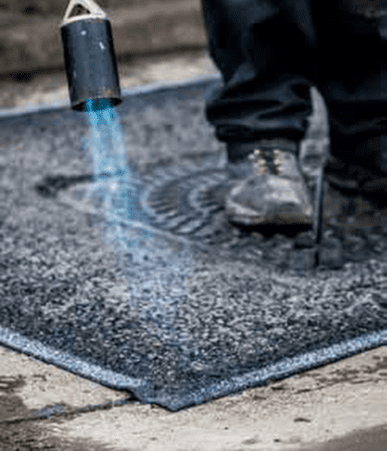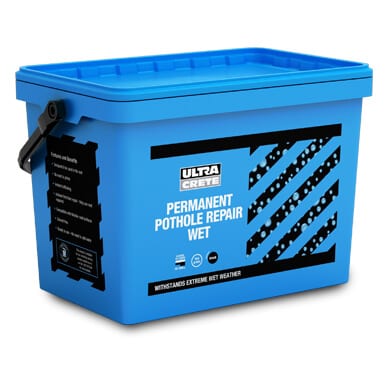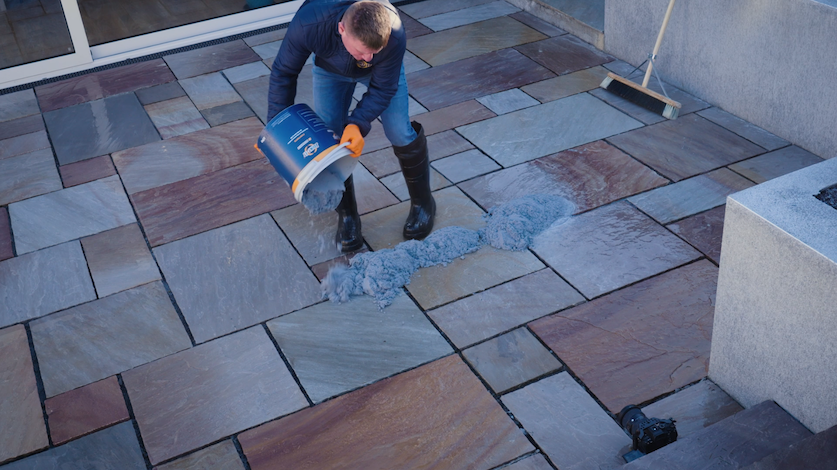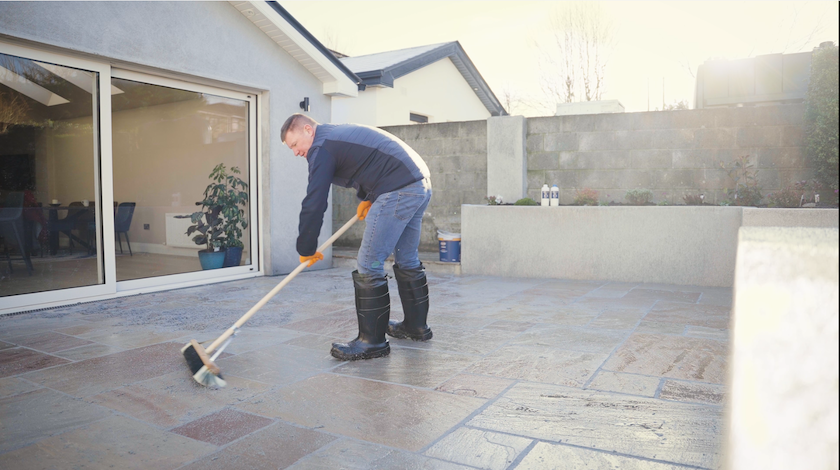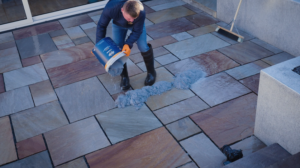If you’re in the business of resurfacing and landscaping then repairing potholes is likely to be your bread and butter. But no matter how much you’re accustomed to pothole repair, there’s no harm in a recap of industry tips and the latest materials for permanent repairs and keeping your clients happy.
Read our pothole repair 101 – an essential guide to commercial pothole repairs, including tips on how to ensure your repair job lasts a lifetime and the recommended products for professionals such as cold-lay tarmac and ‘off-the-shelf’ hot-lay tarmac, which come in handy 25kg bags or tubs.
The UK's growing pothole problem
Potholes are a widespread problem on UK roads, causing ongoing damage to vehicles and serious safety risks. The RAC reports that one-third of UK drivers suffer pothole damage to their cars.
In fact, potholes are now the fastest-growing concern for the country’s motorists. IAM Roadsmart reported in their annual Safety Culture Report that drivers today are more concerned about potholes than they are about other drivers who text or talk on a mobile phone while on the road.
Government funding for pothole repairs
The government handed £500 million to local councils in 2021 to help fix England’s local roads.
It costs roughly £50 to repair a pothole, meaning that 10 million potholes could be fixed with that kind of money.
This cash injection was the second of five instalments in the Potholes Fund. Worth a total of £2.5 billion for fixing England’s roads, the fund runs until 2024/25.
Staggeringly, this £500m is just part of the funding the Department for Transport allocated for road maintenance across England in 2021, which totals over £1.1 billion.
Role of commercial contractors
As a commercial contractor or subcontractor, you may be asked to repair asphalt on:
- Public roads, including main carriageways and motorways
- Private roads
- Carparks
- Service station surfaces
- Commercial and domestic driveways
- Public and private paths
- Cycle lanes
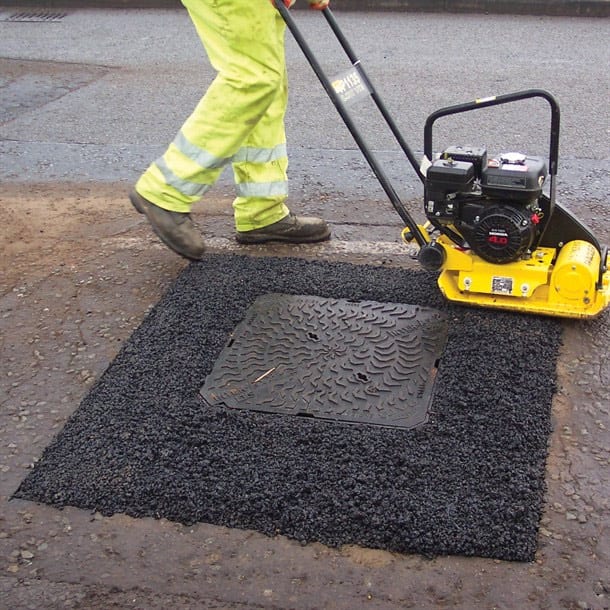
As a professional public works and reinstatement contractor, it’s likely you’re already accustomed to the annual ‘pothole season’. Yes, it’s the time when many local authorities come knocking on your door to spend their money before the end of the financial year.
With growing demands on local highways authorities for reinstatements, there is much scope for boosting your surfacing or reinstatements business by landing regular contracts.
Choosing asphalt fillers: hot-mix vs cold-lay tarmac
When repairing potholes on a commercial scale, hot-lay tarmac tends to be the product of choice for the industry due to its strength and ease of application.
However, a hot mix is not always feasible for smaller jobs and domestic repairs. Hot-lay tarmac requires heavy duty machinery, such as an insulating paver machine, to lay the bitmac and keep it above the required temperature before application.
This is where cold-lay tarmac comes in. As a more affordable option, it is often considered for purely temporary reinstatements with many thinking that repairs made with cold-lay macadam are just for a season.
But suppliers have upped the ante over recent years and we now have cold-lay tarmac on the market that is widely used by public works and civils contractors for permanent pothole repairs. You just have to follow the recommended process to keep those repairs long-lasting (see below for a full outline).
If you prefer to use a hot-lay tarmac, Ultracrete recently released Enviro Mastic to offer a first-time permanent repair job to footpaths, cycle tracks and even carriageways.
Ideal for more remote locations and SROH compliant, Enviro Mastic offers long-term wear resistance, no voids and doesn’t even require plate compaction (a hand-held tamp will do). You will need a mastic mixer to get the surfacing material to the right temp for application.
Professional pothole repair products
Ultracrete’s Instant Road Repair and (as the name suggests) Permanent Pothole Repair are two tried and trusted products offering fast, permanent reinstatements without breaking the bank.
Known in the industry as IRR and PPR, both products require limited equipment allowing repairs to be easily (and more cheaply) carried out in hard-to-reach locations.
Both HAPAS approved since 2002 (that’s the Highway Authorities Product Approval Scheme to the uninitiated), IRR and PPR are cold-lay macadam fillers used and trusted by local authorities, and major civils and utilities contractors nationwide.
IRR comes in 6mm-grade aggregate (for footpaths, cycle lanes and driveways) and 10mm-grade aggregate for more skid resistance, which is suitable for Types 3 and 4 roads, carriageways, car parks, private roads and industrial estates (along with the smaller paths and lanes that don’t require as much grip).
Most of these products are suitable for reinstatements of up to 100mm deep. And in terms of power tools, all you’ll need is a circular saw, and possibly a plate compactor – but a hand tamp can also do the job.
Process for permanent pothole repairs
Surfacing specialist and manager of Facebook’s Civils Groundwork & Tarmac Talk Group, Dan Cloke, says that the major reason why potholes fail is ultimately due to time – or more accurately, the lack of.
“Patchwork can be tedious, especially when there are many potholes to patch-up on a road,” he explains. “But a wise old boy once told me, ‘What’s on top is only as good as what’s underneath’. If the groundwork (excuse the pun) is poor, then the job is just not going to last.”
As a contractor, you’ll be well aware of the groundwork that is needed to protect pothole repairs from water ingress. But there’s no harm in a little recap of the process for prepping and fixing a pothole.
This process is effective with the cold-lay tarmac products mentioned earlier, for fast and permanent repairs to potholes of up to 100mm deep.
Step 1: Cut a neat picture frame and remove debris
This step is essential for creating smooth vertical edges that the asphalt filler can strongly adhere to.
Once the hole is free from dirt, debris and standing water, use a circular saw to cut neat, vertical edges around the reinstatement area, effectively creating a picture frame. Remove all remaining debris from the hole.
“Clean joints, where the verticals are shelved to support the joint, are a must,” shares Dan. “It’s crucial to cut around each reinstatement area with a circular saw to create those vertical edges and remove all debris and standing water.”
Step 2: Seal the reinstatement
Next, apply a cold jointing spray to seal the vertical edges and base of the hole. Dan says, “Ultracrete SCJ spray is a great vertical joint emulsion as it helps to bond the face of the reinstatement.”
Step 3: Start layering the tarmac
Pour the first layer of tarmac to a depth of 45mm and fully compact it with a hand tamp. Reapply cold joint spray to the edges and base, then add another layer of 45mm and tamp again.
“Poor back-fill of materials in the pothole and poor compaction are the two major contributing factors that create the conditions for a pothole to fail,” explains Dan.
“Aim for lifts of no more than three times the depth of your stone in your mix. Yes, it may seem like overkill, but it is the best way to achieve full consolidation of the material.”
On the final layer, use a plate compactor until the tarmac is flush with the surface of the road.
Step 4: Prevent water ingress
With near-on 20 years under his belt in installing major civils projects, Dan highlights the need to always seal a reinstatement’s lateral joints.
“Ultracrete Instaband is another great overseal that I regularly opt for as opposed to oxidised blown pitch. It’s a far better method in my opinion purely because of the speed and quality of the undertaking.”
Repairing holes of more than 100mm deep
Tried and tested advice for repairing larger reinstatements is to avoid deep, vertical joints by stepping the joint lifts whenever possible.
Dan explains, “Vertical joints that are unable to laterally support the weight or volume of traffic are the biggest cause of failure in larger potholes.”
Step the lift in larger potholes by adding a sub-grade at the bottom followed by base course, binder course and wearing course at the top.
“You effectively create a staircase effect between the layers of construction. This is not always achievable with pothole repairs, but on larger reinstatements it is possible and best practice.”
Another tip for larger potholes is to ensure the sub-grade is fully compacted by testing it with a Clegg hammer. “If you can, Clegg-test the subgrade to ensure good compaction.”
Skid resistant repairs
“Maintaining the correct PSV (aka polished stone value) is essential for creating a safe and robust reinstatement for skid resistance, particularly for carriageways and turning circles for lorries,” explains Dan.
“The best course of action is to contact your local authority and ask what material they stipulate to give you the PSV value of the existing surface course. High PSV is anything above 68. This is the national go to for us in the UK.
“Another good option is Tough Patch, which has a high minimum skid resistance value of 65. It’s also rut resistant and is set through a chemical reaction with water rather than compaction.”
For ultimate skid resistance on heavily trafficked roads and wheel turning locations such as crossroads, junctions, traffics, roundabouts and car parks, Tough Patch, available with 6mm-grade aggregate and, by contacting The Paving Experts, 10mm-grade aggregate by order, which will certainly handle the extra grip required – even during wet weather.
For patching the odd crack or pothole in roads, Tough Patch is another quick-to-cure formula that can receive traffic immediately afterwards. As a contractor, you can quickly fill the hole and move onto the next job (and vehicle drivers will thank you too when those traffic management cones can be removed!).
Just like the other cold-lay tarmacs, applying Tough Patch requires minimal tools and labour, and it is quick and easy to pour from the bucket. It is suitable for permanent repairs to footways, footpaths and cycle tracks and can be used for temporary or emergency repairs on Class 3 and 4 carriageways having passed all tests in the revised Specification for Highway Works (SHW), Clause 946, which is defined in the Specification for the Reinstatement of Openings in Highways (SROH).
Wet weather pothole repairs
Monitoring the weather conditions is often a big consideration for surfacing contractors. The last thing you want is water in the reinstatement area as it increases the likelihood of water ingress that leads to pothole failures.
Both Tough Patch and PPR Wet can be applied during wet weather. PPR Wet also contains a larger aggregate that can provide the resistance needed for roads, driveways and carparks.
Repairing red tarmac
Red tarmac is often used for traffic calming and road markings, and for bus lanes, cycle tracks and even colour-coded car parks. Some householders also choose red tarmac for their bitumen driveways.
Luckily there is a red-coloured cold-lay tarmac for fixing red reinstatements. IRR RED is ideal for permanent repairs to cushions and ramps, bus lanes, bus stops, cycle paths, driveways, car parks and even on roads.
Red tarmac is sometimes used within blocks of white diagonal lines to visually divide the road and separate traffic moving in opposite directions. This coloured alternative to common black bitumen is also commonly used today as a traffic calming measure and even as part of a remedial scheme following an accident to reduce the likelihood of it occurring again.

Safety essentials when repairing roads
As a commercial contractor you should always follow Chapter 8 of your Risk Assessment and Method Statement (RAMS). This chapter details your risk assessment for the job and is an essential requirement to complete.
Dan explains, “Although it is not yet legislation, you could still find yourself in hot water if you don’t have this and HSE won’t be very understanding.”
Also, if you haven’t already, join the Street Works Qualifications Register (SWQR) to become a more attractive option to local authorities during their tender process. Inclusion on SWQR demonstrates your company’s aptitude to perform safely and shows that your staff have the required background knowledge to complete pothole repairs safely and effectively.
Dan summarises that the conduct and approach of a company is vital for creating long-lasting pothole repairs. “We all know it in the industry, but there are occasions when some decide to cut corners to save on time and labour.
“Although it can take time, following the recommended steps for pothole repair is worth it in the long-run – for a job that lasts and that helps gain repeat business from satisfied clients.”
Read the full interview with Dan where he shares his trade secrets for permanent repairs.
Call us for tailored advice
Get in touch with our team of tarmac and pothole repair experts if you want to discuss the ins and outs of each of the products available for repairing reinstatements on larger projects and what would best suit your client’s requirements.
Our team is available Monday to Friday (8.30am to 5.30pm) on 0330 122 1025. We’re happy to help and there is no obligation to buy (but bear in mind that we do have some of the best pallet and part-pallet deals available in the industry!).
Based centrally in Tamworth, Staffordshire, we can deliver quickly within the area. Delivery is also available within mainland UK.

